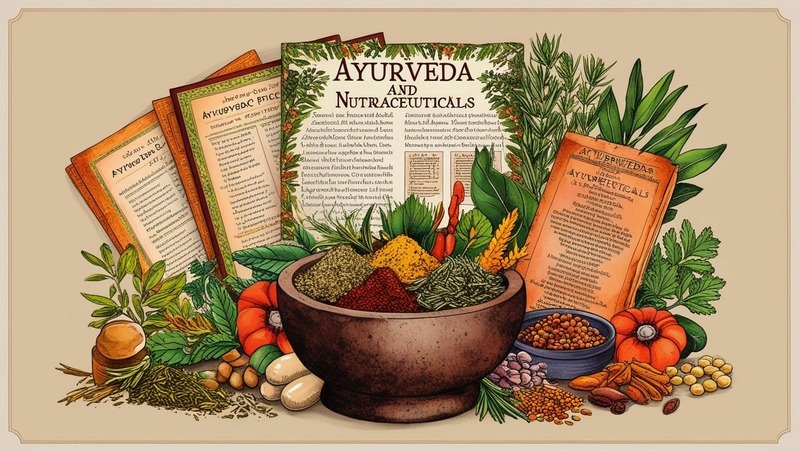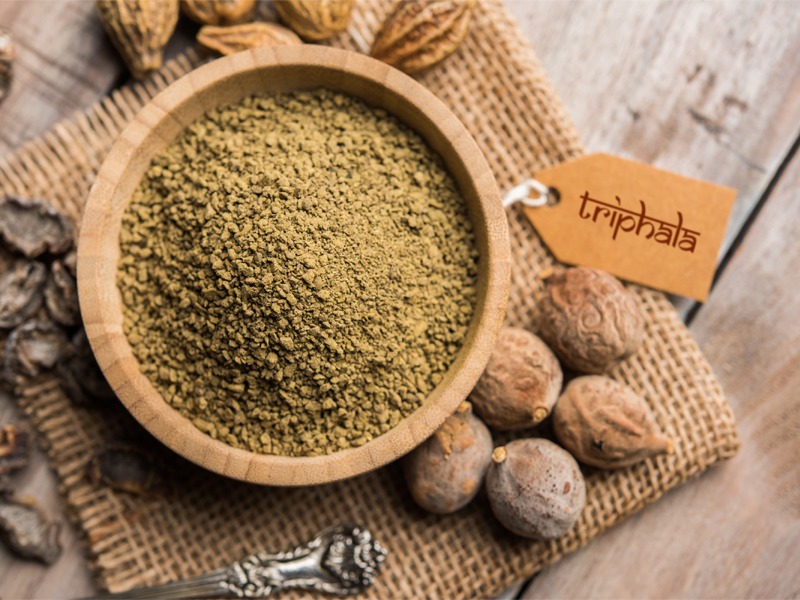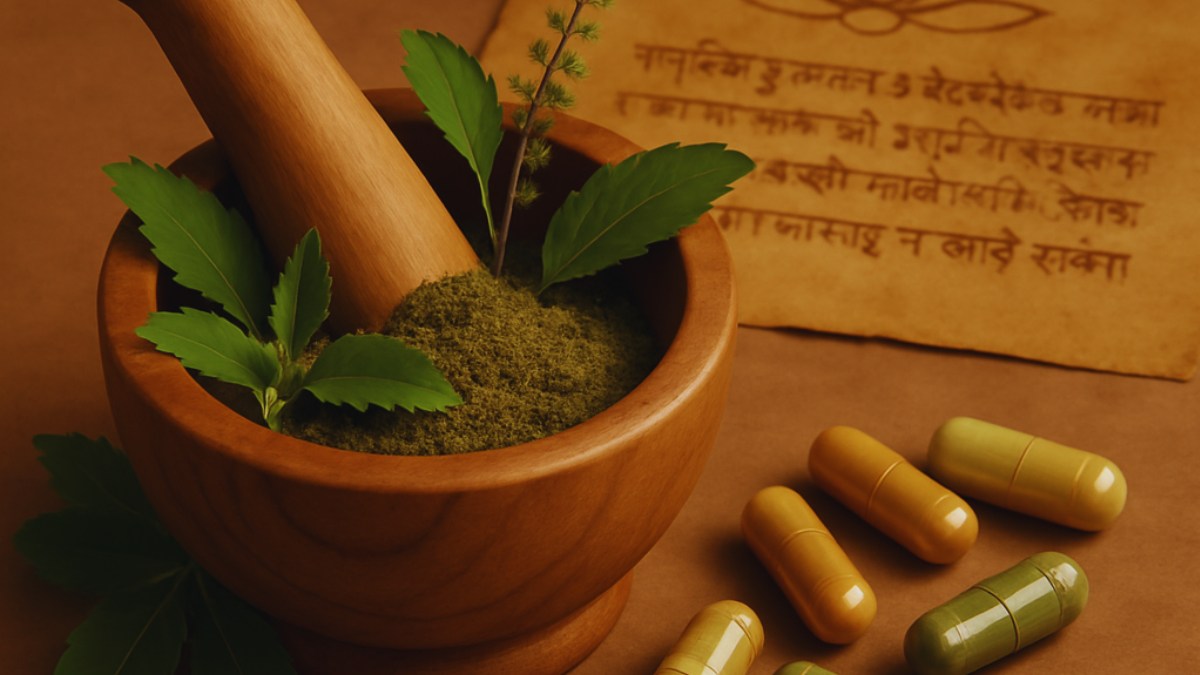Ayurveda is not just surviving the modern world, it’s shaping it. Its philosophies are being woven into cutting-edge wellness products, its herbs reimagined into capsules, gummies and clinical extracts. Its wisdom decoded for modern research and regulatory frameworks. Where turmeric was once a kitchen spice, it’s now a bioactive compound. Where Ashwagandha was once a tonic for sages, it’s now a global stress-relief staple.
The nutraceutical industry, driven by the demand for natural, science-backed, preventive care has become Ayurveda’s newest frontier. And what makes this journey extraordinary is not just its longevity, but its seamless evolution.

Ayurveda’s Origin: The Seed of Holistic Health
The word Ayurveda comes from Sanskrit, Ayur meaning life, and Veda meaning knowledge. Put together, it means the “science of life.” Ayurveda emphasize the prevention of disease and the preservation of health. It approached human wellbeing as a dynamic balance between the body, mind and spirit.
Its foundational concepts such as the Tridosha theory (Vata- the air element, Pitta- the fire element, and Kapha-the water element), Agni (digestive fire), Ama (toxins), and Rasayana (rejuvenation) weren’t just therapeutic. They were preventive, personalized, and profoundly aligned with nature. The ancient texts, the Charaka Samhita, Sushruta Samhita, and Ashtanga Hridaya described thousands of herbal and mineral preparations, dietary rules and lifestyle codes.
These weren’t random recipes but meticulously structured protocols based on empirical observation over generations. From its earliest days, Ayurveda established a concept strikingly similar to modern nutritional science. It emphasized food as medicine, encouraged seasonal and constitution-based eating, and prescribed botanical formulations for maintaining vitality, enhancing immunity, and promoting longevity.
Preservation Through Adversity: The Middle Ages to Colonial Times
Despite the profound depth of Ayurvedic knowledge, it faced major challenges during India’s colonial period. The arrival of Western biomedicine and the British rule led to the systematic devaluation of traditional systems. Ayurvedic institutions were defunded and formal recognition was withdrawn in favour of allopathy.
However, Ayurveda endured not in grand hospitals or medical colleges, but within homes, temples, and oral traditions. Village Vaidya’s, tribal healers and classical scholars continued to practice and transmit Ayurvedic wisdom quietly.
The Post-Independence Renaissance and Standardization
The tide began to turn after India gained independence in 1947. Recognizing the value of indigenous knowledge systems, the Indian government established institutions like the Central Council for Research in Ayurvedic Sciences (CCRAS) and later the Ministry of AYUSH. They worked toward standardizing Ayurvedic education, research, and product development. During this phase, brands like Dabur, Zandu, Himalaya, and Baidyanath began transforming Ayurveda from a household tradition into a commercial health solution. Products like Chyawanprash, Ashokarishta and Triphala churna found their place in urban Indian homes and the idea of Ayurveda as a mass-consumable system began to take shape.
This period also marked the initial steps toward blending Ayurvedic wisdom with modern production techniques. The seeds for integration into the nutraceutical industry were thus quietly sown though no one called it that yet!
Scientific Validation and Global Curiosity
The turning point came in the late 20th and early 21st centuries when global interest in plant-based and preventive health had skyrocketed. Ayurveda, with its holistic approach and plant-based pharmacopeia, naturally rose to attention. Through phytochemical analysis, clinical studies, and bioavailability enhancements, scientists began validating the efficacy of herbs that had been used in Ayurveda for centuries. Ingredients such as Ashwagandha, Turmeric (Curcumin), Brahmi, Shatavari, and Guduchi began to be studied and adopted globally. They started appearing in capsules, teas, protein powders and functional beverages all under the umbrella of what is now known as nutraceuticals.

Understanding Nutraceuticals and Ayurveda’s Natural Fit
Nutraceuticals, a term combining “nutrition” and “pharmaceuticals,” refers to food-derived products that offer medical or health benefits, including the prevention and treatment of disease. These can be in the form of fortified foods, dietary supplements, functional beverages or herbal extracts.
Ayurveda’s intrinsic focus on food as medicine makes it a natural fit for the nutraceutical model. Unlike synthetic supplements, which often isolate a single compound, Ayurvedic formulations emphasize synergistic actions, a concept now being explored in modern herbal pharmacology. For instance, Triphala, a formulation of three fruits, is known not just for digestive support but for its antioxidant and detoxifying properties. Ashwagandha, revered for centuries as a Rasayana, is now sold worldwide as an adaptogenic stress-relief supplement.
From such herbal extract suppliers and third-party manufacturers to R&D firms, Ayurveda offers a goldmine of opportunities. Indian companies are increasingly exporting standardized botanical extracts like Withania somnifera (Ashwagandha root extract), Curcuma longa (Curcumin 95%), and Ocimum sanctum (Tulsi extract) to manufacturers in the United States, Europe, Japan, and the Middle East. Partnerships are also emerging between Ayurvedic formulators and nutraceutical brands, where traditional formulations are adapted into modern delivery formats like capsules, tablets, gummies, effervescent powders, and even ready-to-drink herbal tonics.
Regulatory and Standardization measures
One of the most important developments enabling this evolution has been regulatory recognition. In India, creation of the Food Safety and Standards Authority of India (FSSAI) provided a framework for functional foods and health supplements under the nutraceuticals category giving Ayurvedic ingredients a legitimate status in the food industry. Globally, in the U.S., they are categorized as Dietary Supplements under the DSHEA act. In the European Union, ingredients are regulated under novel food or botanical guidelines. Countries like UAE, Australia and Canada are also in the process of opening up to traditional herbal products provided they meet scientific and safety benchmarks. To support the same, India has launched the Traditional Knowledge Digital Library (TKDL), a database that documents Ayurvedic formulations to prevent bio-piracy and promote intellectual property rights.
Innovation at the Crossroads: Modern Ayurveda in Action
What’s especially exciting is how Ayurveda is not merely being used as it was, but is being reimagined through modern innovation. Today’s Ayurveda-inspired nutraceuticals are not just powders in jars or churnas in pouches. They come as flavored effervescents, stress-relief gummies, protein blends for specific prakritis, and even nootropic drinks with Brahmi and Shankhpushpi.
Technology is also playing a major role. Startups are using AI to deliver personalized supplements based on dosha profiling, blood markers, and lifestyle data. Sustainability practices such as organic certification, wild harvesting, and traceable sourcing are adding value and authenticity to Ayurvedic nutraceuticals.
This convergence of ancient wisdom and modern science is opening doors to next-gen product development that resonates with conscious consumers and are right at the heart of this shift.

Challenges in the Journey Ahead
Despite all the progress, integrating Ayurveda into the global nutraceutical ecosystem is not without challenges. Many herbs still lack large-scale clinical validation in modern settings. Standardization of polyherbal formulations remains complex. There is also a risk of dilution or misrepresentation when Ayurvedic terms and concepts are used loosely for marketing without authenticity.
Education remains a key hurdle international partners and formulators often require guidance in understanding how Ayurvedic principles translate into measurable outcomes in the supplement world. Regulatory compliance, too, is an ongoing process, requiring continuous research, documentation, and collaboration.
Step Into the Legacy, Shape the Future
Whether you are a wellness entrepreneur, a healthcare innovator, a product developer, or simply someone seeking a more natural path to vitality, now is the time to engage with Ayurveda’s renewed journey. Invest in research, explore ethical sourcing, collaborate with authentic practitioners to create and honour both tradition and innovation. The world doesn’t just need more supplements, it needs solutions rooted in wisdom and integrity. Step into the future with Ayurveda not as a trend, but as a timeless ally in building a healthier, more balanced tomorrow.
Conclusion: A Timeless Science in a Timely Industry
The evolution of Ayurveda into the nutraceutical industry is a story of resilience, relevance, and renewal. It has journeyed from sacred palm-leaf manuscripts to pharmaceutical-grade extraction units, from home remedies to global capsules, and from traditional wisdom to scientifically backed wellness products.
This is more than just a commercial trend. It is a chance to be part of a legacy that marries nature and science, culture and commerce, heritage and health. As the global wellness market expands, Ayurveda offers not just products but a powerful story, a deep-rooted philosophy, and a timeless promise: to heal from within.







